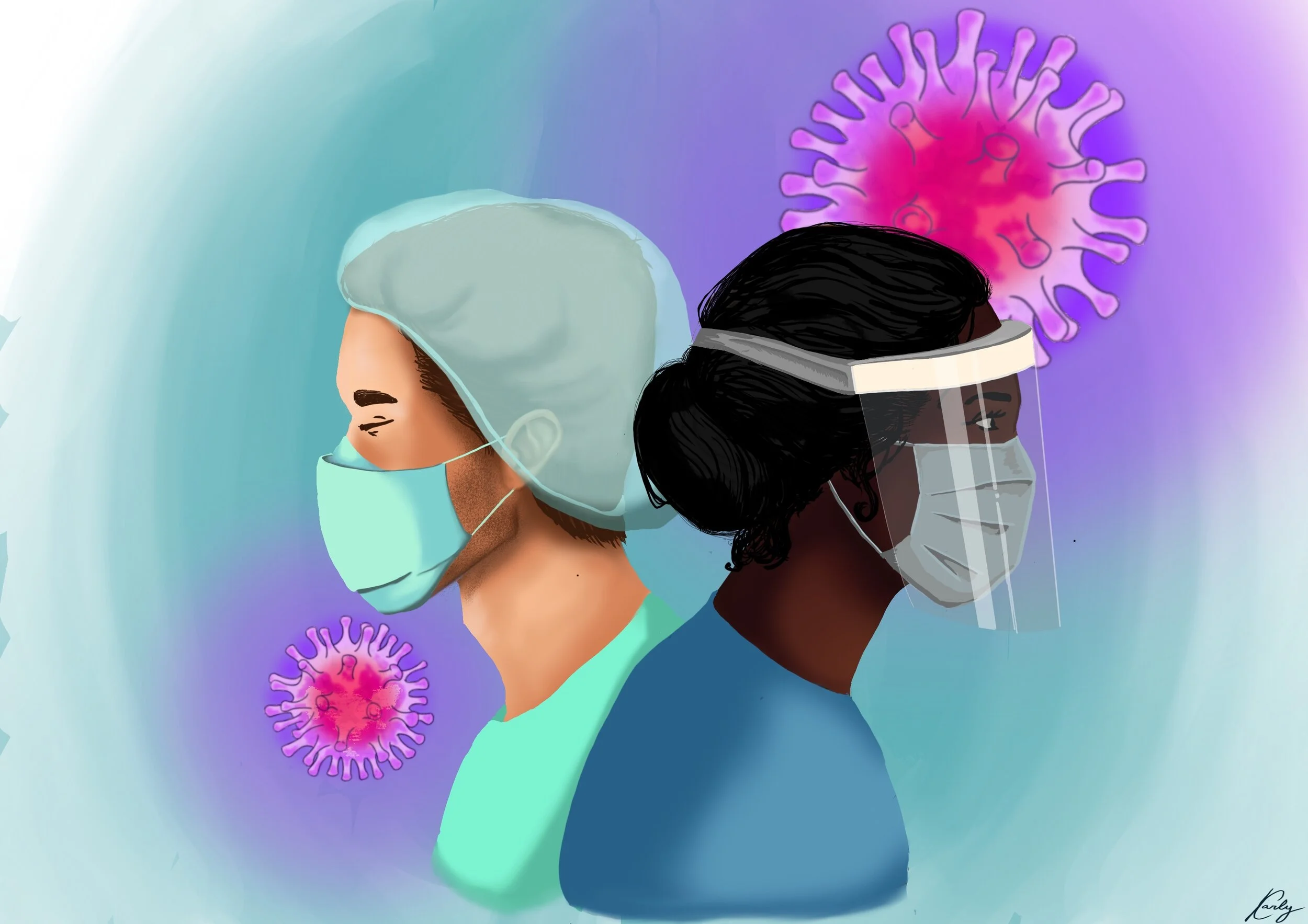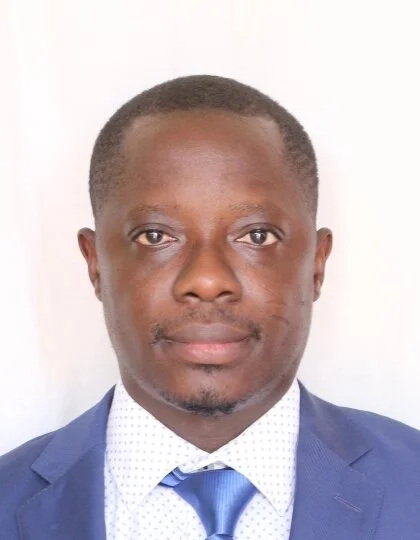The Year of the Nurse and Midwife in a COVID-19 Pandemic: Reflections of a Nurse
The beginning of 2020 carried great expectations for nurses and midwives across the globe. In May 2019, the World Health Organization (WHO) nominated the year 2020 as the Year of the Nurse and the Midwife (YONM). This year-long campaign was aimed at recognizing the work of nurses and midwives by celebrating their work, highlighting the challenges they face, and advocating for increased investment in the nursing and midwifery workforce to achieve the Sustainable Development Goals [1,2]. The year also coincided with the bicentenary of the birth of Florence Nightingale, who is widely acknowledged as the founder of modern nursing. In this article, I reflect on 2020 as a unique year for nurses and midwives, and how expectations about the year may have been impacted by the emergence of the COVID-19 pandemic.
Original illustration created by Karly Franz.
2020, A Year Like No Other for Nurses and Midwives
The declaration of 2020 as the YONM among other things was potentially a key strategy to leverage the work of nurses and midwives in achieving global health goals given nurses’ unique position within health care systems. It is estimated that nurses account for more than half (approximately 59%) of the global health workforce, and are often the first and only health care staff seen by a patient in some parts of the world, thus ensuring that people in the hard to reach areas get access to health care [2,3]. Two other global nursing events scheduled for 2020, the Nursing Now Campaign and the launch of the State of the World’s Nursing (SOWN) Report, were in concert with the YONM to make 2020 a significant year for nurses and midwives. Firstly, the three-year Nursing Now campaign, launched in 2018 by the Burdett Trust for Nursing, the International Council of Nurses (ICN), and the WHO was ending in 2020. The Campaign, aimed at improving health globally by raising the profile and status of nursing [1], was initiated following findings from the Triple Impact Report, a publication by the UK All-Party Parliamentary Group on Global Health, which showed that investment in the nursing workforce leads to improved health, promotes gender equality, and supports economic growth [4]. Secondly, the WHO’s SOWN Report was scheduled to be launched in April 2020. The Report was the first of its kind to provide data on the numbers and cadre of nurses globally and provide country-specific data to gauge progress and set future directions [5]. 2020 was therefore envisaged to be a year for nurses and midwives to be appreciated and recognized, advocate for investing in more education, jobs, and leadership for nurses and midwives [5]. With the end of 2020, one could not help but wonder how the YONM may have turned out and what outcomes would have been achieved had COVID-19 not disrupted some of these plans. As a nurse who administers direct patient care, I wonder how the year would have been, and how events might have turned out had COVID-19 not emerged.
How I Had Imagined the 2020 YONM
The year began with much anticipation of celebrating the YONM and making the most of the opportunity that the Year presented. My experiences working as a nurse in a low- and middle-income country (LMIC) such as Ghana for the past decade have caused me to believe that the YONM would lead to an even greater impact for nurses and midwives in LMICs. Nurses and midwives in LMICs are disproportionately affected by the issues that impact health workers globally, including social inequalities, unsafe working conditions, low pay, and inadequate government investment in health care [6]. Consequently, I had anticipated that events planned for the YONM would promote increased engagement of nurses and midwives with policymakers, stakeholders, the media, and the public to contribute to addressing these barriers.
I had imagined the year to be filled with many events organized by international nursing organizations, national ministries of health, professional nursing associations, and other nursing groups. The ICN had a number of key events/activities planned for the year and had encouraged individual nurses and organizations to plan activities. These events, without a doubt, would have involved more in-person gatherings of nurses, stakeholders, and policymakers, particularly at the country level. Speeches would have been delivered at these events covering topics about nursing’s contributions to health systems, and the need for greater investment in nurses and midwives to achieve universal health coverage goals (UHC). I had expected that awards would be presented during such events to individual nurses and nurse leaders, as well as nursing organizations in recognition for their contributions to health care.
At each country level, I had looked forward to national governments communicating their commitment and plans for investing in the nursing and midwifery professions. In Ghana, I had looked forward to hearing what plans the government has for investing in nurses and midwives. However, the postponement of a press briefing scheduled by the Ghana Ministry of Health in March 2020 to mark the Year means such expectations remain unfulfilled.
I had anticipated an increase in nurses’ engagement with the media, including television and radio appearances to speak about the YONM and provide public education through the media to increase public understanding of the work of nurses and midwives. It is generally acknowledged that nurses are often insufficiently featured in the media to share views pertaining to national health issues, yet nurses and midwives are well placed in healthcare systems to contribute to policy dialogue. But with the COVID-19 outbreak by January 2020, activities related to the YONM may have been somewhat different from what was expected.
The 2020 YONM Under COVID-19 Pandemic
The emergence of COVID-19 in early 2020 dramatically changed the celebratory mood within the year and ironically made 2020 a more challenging year for nurses and midwives as they battled an infectious disease with limited vital resources, such as personal protective equipment [7]. The outbreak of the COVID-19 pandemic in a year dedicated to honouring nurses and midwives was as if nurses were being tested by the pandemic to see how well they would endure in their commitment, courage, and resilience as they strive in “nursing the world to health.” [8] Although events planned to honour nurses under the YONM were cancelled, postponed, or modified to be held online, the work and challenges facing nurses and midwives were highlighted by the pandemic, and contributed to achieving some of the outcomes of the YONM.
Nurses’ critical role within health systems has been well demonstrated under the pandemic. Across the globe, irrespective of country and setting, nurses have been at the forefront of the global response to the pandemic. Whether it is planning and implementing COVID-19 education at the community level, restructuring workflows at the hospital level, accommodating COVID-19-related interventions, testing and contact tracing, or clinical care of COVID-19 patients, nurses have been leading the way. With the commencement of COVID-19 vaccination in some countries, nurses are championing these efforts to deliver vaccines to targeted populations [9]. These critical roles played by nurses appear to have increased public recognition of nurses’ work, as exemplified by the clapping and shouting of praises from rooftops in some countries such as the US, UK, and Italy during the lockdown periods [10]. The media is increasingly focusing on nurses and their work during the pandemic, and words such as “heroes” and “angels” are being used to describe nurses for their role in the current pandemic. While such support and acknowledgement of nurses by the public is generally welcomed, some nurse authors express worry that the “hero-angel” narrative has the tendency to undermine the professionalism of nursing and reinforces stereotypes [11]. Arguably, although the YONM may not have happened as originally intended due to the pandemic, events that unfolded during the pandemic communicated a strong need for investing in nurses and midwives to guarantee global health security.
The Next Decade of Action
The need to strengthen health systems globally and commit to investing in nurses and midwives to safeguard the health of the world’s population has been revealed by the COVID-19 pandemic. A key challenge highlighted by the pandemic is the nursing and midwifery shortages. The world was struggling with the nursing deficit, and the pandemic revealed the world was unprepared in terms of workforce numbers, and how these nursing shortages negatively impact the health and wellbeing of patients and health care staff. The SOWN Report estimates that the current global nursing workforce stands at 27.9 million, and an additional 5.9 million will be required by 2030 to achieve UHC [6]. International organizations including the WHO and ICN have contributed clear policy documents to support and guide greater investment in the nursing and the midwifery workforce. What therefore remains for governments across the world is to commit to work and make the next 10 years truly a decade of action in further developing the nursing and midwifery professions.
Stephen Adombire, RN, MScN, is a Registered Nurse in Ghana and a second-year PhD Nursing Science student at the Lawrence S. Bloomberg Faculty of Nursing, University of Toronto. His research interests include Evidence-Based Health Care, with emphasis on Evidence-Based Nursing; Knowledge Translation/Implementation Science; and Global Health.
References
[1] Nursing now. Who we are [cited 2021 October 16, 2021]. Available from: https://archive.nursingnow.org/who-we-are/
[2] Catton H, Iro E. How to reposition the nursing profession for a post-covid age. bmj. 2021;373.
[3] UHC2030. International Council of Nurses: why nurses are so important for UHC 2019 [cited 2021 October 16, 2021]. Available from: https://www.uhc2030.org/blog-news-events/uhc2030-news/partner-insights/international-council-of-nurses-why-nurses-are-so-important-for-uhc-555297/.
[4] World Health Organization. Triple Impact: How developing nursing will improve health, promote gender equality and support economic growth 2016 [cited 2021 October 16, 2021]. Available from: https://www.who.int/hrh/com-heeg/digital-APPG_triple-impact.pdf.
[5] World Health Organization. State of the World’s Nursing Report - 2020 2020 [cited 2021 October 16, 2021]. Available from: https://www.who.int/publications/i/item/9789240003279.
[6] Filby A, McConville F, Portela A. What prevents quality midwifery care? A systematic mapping of barriers in low and middle income countries from the provider perspective. PloS one. 2016;11(5):e0153391.
[7] Turale S, Meechamnan C, Kunaviktikul W. Challenging times: ethics, nursing and the COVID‐19 pandemic. International nursing review. 2020;67(2):164-7.
[8] International Council of Nurses. International Council of Nurses: Nursing the World to Health 2020 [cited 2021 October 16, 2021]. Available from: https://www.icn.ch/news/international-council-nurses-nursing-world-health.
[9] International Council of Nurses. Report on the role of nurses in COVID-19 Mass Immunisation 2021 [cited 2021 October 16, 2021]. Available from: https://www.icn.ch/sites/default/files/inline-files/Report%20on%20the%20role%20of%20nurses%20in%20COVID19%20pandemic.pdf.
[10] Day G, Robert G, Leedham‐Green K, Rafferty AM. An outbreak of appreciation: A discursive analysis of tweets of gratitude expressed to the National Health Service at the outset of the COVID‐19 pandemic. Health Expectations. 2021.
[11] Stokes‐Parish J, Elliott R, Rolls K, Massey D. Angels and heroes: The unintended consequence of the hero narrative. Journal of Nursing Scholarship. 2020.


